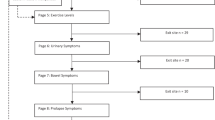Abstract
Introduction and hypothesis
The purpose of this study was to determine the prevalence of stress urinary incontinence (SUI) in recreationally active women attending gyms or exercise classes.
Methods
Data were collected on the frequency and severity of incontinence and the prevalence of SUI risk factors; screening for PFM dysfunction in a fitness appraisal; symptom modification strategies; knowledge of pelvic floor muscle (PFM) exercises and the Pelvic Floor First (PFF) initiative.
Three hundred and sixty-one women aged 18–83 who attended exercise classes or gyms in Western Australia were surveyed.
Results
Nearly half (49.3 %) of participants reported SUI, the majority of whom slight or moderate leakage. Ninety-six per cent reported at least one SUI risk factor, with the mean being 2.7 (SD = 1.4). Almost all women surveyed had heard of PFM exercises (97.2 %), but only 15.2 % of participants were screened for PFM dysfunction in a fitness appraisal. Forty-three per cent reported that a fitness instructor cued PFM activation during a workout. Less than 1 in 10 (9.7 %) of the women surveyed had heard about the PFF initiative.
Conclusion
Urinary incontinence is common in women attending gyms or exercise classes, but is rarely screened for. More education is required to encourage fitness leaders to screen exercise participants and to provide PFM-’friendly” modifications.
Similar content being viewed by others
References
Jean-Baptiste J, Hermieu J (2010) Sport and urinary incontinence in women. Prog Urol 20(7):483–490
Bo K (2004) Urinary incontinence, pelvic floor dysfunction, exercise and sport. Sports Med 34(7):451–464
Nygaard I, Girts T, Fultz N et al (2005) Is urinary incontinence a barrier to exercise in women? Obstet Gynecol 106(2):307–314
Koelbl H, Nitti V, Baessler K et al (2013) Pathophysiology of urinary incontinence, faecal incontinence and pelvic organ prolapse. In: Abrams P, Cardozo L, Khoury S et al (eds) Incontinence, 5th edn. Health Publications, Plymouth, pp 255–330
Eliasson K (2002) Prevalence of stress incontinence in nulliparous elite trampolinists. Scand J Med Sci Sports 12(2):106–110
Caylet N, Fabbro-Peray P, Marès P et al (2006) Prevalence and occurrence of stress urinary incontinence in elite women athletes. Can J Urol 13(4):3174–3179
Thyssen HH, Clevin L, Olesen S et al (2002) Urinary incontinence in elite female athletes and dancers. Int Urogynecol J Pelvic Floor Dysfunct 13(1):15–17
Fozzatti C, Riccetto C, Herrmann V et al (2012) Prevalence study of stress urinary incontinence in women who perform high-impact exercises. Int Urogynecol J 23(12):1687–1691
Jacome C, Oliveira D, Marques A et al (2011) Prevalence and impact of urinary incontinence among female athletes. Int J Gynaecol Obstet 114(1):60–63
Salvatore S, Serati M, Laterza R et al (2009) The impact of urinary stress incontinence in young and middle-age women practising recreational sports activity: an epidemiological study. Br J Sports Med 43(14):1115–1118
Miller J, Sampselle C, Ashton-Miller J et al (2008) Clarification and confirmation of the Knack maneuver: the effect of volitional pelvic floor muscle contraction to preempt expected stress incontinence. Int Urogynecol J 19:773–782
Egger M, Lukacz E, Newhouse M et al (2013) Web versus paper-based completion of the epidemiology of prolapse and incontinence questionnaire. Female Pelvic Med Reconstr Surg 19(1):17–22
Sandvik H, Espuna M, Hunskaar S (2006) Validity of the incontinence severity index: comparison with pad-weighing tests. Int Urogynecol J Pelvic Floor Dysfunct 17(5):520–524
Ishiko O, Hirai K, Sumi T et al (2000) The urinary incontinence score in the diagnosis of female urinary incontinence. Int J Gynaecol Obstet 68:131–137
Carls C (2007) The prevalence of stress urinary incontinence in high school and college-age female athletes in the midwest: implications for education and prevention. Urol Nurs 27(1):21–24
Simeone C, Moroni A, Pettena A et al (2010) Occurrence rates and predictors of lower urinary tract symptoms and incontinence in female athletes. Urologia 77(2):139–146
Hay Smith J, Berghmans B, Burgio K et al (2013) Adult conservative management. In: Abrams P, Cardozo L, Khoury S et al (eds) Incontinence, 5th edn. Health Publications, Plymouth
Bo K, Bratland-Sanda S, Sundgot-Borgen J (2011) Urinary incontinence among group fitness instructors including yoga and Pilates teachers. Neurourol Urodyn 30:370–373
Bump RC, Hurt WG, Fantl JA et al (1991) Assessment of Kegel pelvic muscle exercise performance after brief verbal instruction. Am J Obstet Gynecol 165(2):322–327
Thompson J, O’Sullivan P (2003) Levator plate movement during voluntary pelvic floor muscle contraction in subjects with incontinence and prolapse: a cross-sectional study and review. Int Urogynecol J Pelvic Floor Dysfunct 14(2):84–88
Abrams P, Cardozo L, Fall M et al (2002) Standardisation of terminology of lower urinary tract function: report from the standardisation sub-committee of the International Continence Society. Neurourol Urodyn 21:167–178
Author information
Authors and Affiliations
Corresponding author
Ethics declarations
Conflicts of interest
None.
Appendices
Appendix 1



Appendix 2

Rights and permissions
About this article
Cite this article
McKenzie, S., Watson, T., Thompson, J. et al. Stress urinary incontinence is highly prevalent in recreationally active women attending gyms or exercise classes. Int Urogynecol J 27, 1175–1184 (2016). https://doi.org/10.1007/s00192-016-2954-3
Received:
Accepted:
Published:
Issue Date:
DOI: https://doi.org/10.1007/s00192-016-2954-3




